
Fotodiox’s DLX Parabolic Focusing Softbox Is a Hybrid Modifier
Fotodiox has announced the DLX Parabolic Focusing Softbox, a new hybrid softbox/reflector that provides photographers extensive control over the direction and quality of their light.

Fotodiox has announced the DLX Parabolic Focusing Softbox, a new hybrid softbox/reflector that provides photographers extensive control over the direction and quality of their light.

Rotolight has announced a set of new parabolic softbox umbrellas for the AEOS, NEO, or any other similarly sized LED with the promise of its ability to produce high-quality soft light.
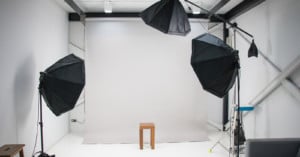
Fill light is one of the unsung heroes in the photographic industry, yet the fill light in basic three-point lighting can be just as important as the key. Getting it right can make your images look much better.
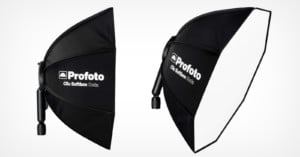
Profoto has announced the new Clic Softbox Octa, a collapsible and magnetic octagonal softbox that is compatible with the company's A and C-series strobes as well as with any other Clic light-shaping tools.

What kind of lighting do you use as a portrait photographer? Softboxes are great and popular, but that also makes them potentially overused and boring. If you want to spice up your portrait lighting, you can look into expanding your toolbox beyond the softbox and into other kinds of lighting.
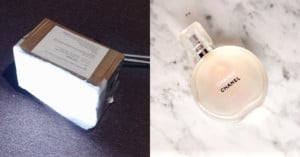
Almost anything can be used as a light modifier. As long as it interacts with light in one way or another, it can be considered a light modifier. In this article, I will show you how to build a do-it-yourself (DIY) softbox with things you likely already have around at home.

We all love soft light because it adds that dreaminess to food and drink photos that will always be great. However, recently I have been seeing more people use hard light in their food and drink photography.

Softboxes are among the most popular light shaping tools. Few photographers have never shot with softboxes, and more often than not a softbox is a go-to modifier for beginners. In this article, I will break down the anatomy of a softbox, from physics to possible applications for it. Read on to become a master of using softboxes.

Cinematographer Shane Hurlbut of the Hurlbut Academy recently shared a great DIY tutorial in which he shows you how to build a giant soft box using just some foam core and a few lengths of 1x3-inch wood. The result allows you to create a large, soft light source without breaking the bank.

Portrait photographer Miguel Quiles is back with the third part of his series on various lighting modifiers. Part one covered the beauty dish, part two covered the umbrella, and part three is all about the different ways you can use a softbox to capture distinctive portraits.

The Elinchrom Rotalux Softbox system is finally complete. 25 years after the popular light shaping system debuted, Elinchrom has finally debuted "Rotagrids" for all 12 modifier shapes, allowing Rotalux users to better control their light spread.

Today we are going to talk about placing a softbox -- not the positions that you would use, like a Rembrandt, a butterfly, or a loop, but how to place it once it’s in position. Let’s talk about how to finesse the look that you want to achieve while using a softbox.

Back in 2013, MagMod launched a game-changing flash modifier system that used magnets instead of Velcro-brand fasteners. Today the company is back again with a "revolutionary" softbox system consisting of the new MagBox, MagRing, MagShoe.

Here's a 10-minute video tutorial in which photographer Kyle Cong shows why a strip softbox is a very handy thing to have if you're shooting portraits on location.

Need to take portraits and don’t have access to a lighting kit? No worries – this 4-minute video from Jay P. Morgan of The Slanted Lens will show you how you can turn a bathroom – or any room for that matter – into a softbox to create beautiful soft light.

When you’re taking corporate headshots, you often have a tight window in which to fit everything in. But usually you're also going to be expected to create more than one look. Jay P. Morgan of The Slanted Lens runs through his simple setup in this 5 minute video.

Want to try out product photography but can't afford a softbox? They can be expensive pieces of kit, but invisible ones cost a lot less. In this 6-minute video by Leo Rosas, learn how to use a cheap tube light as a makeshift softbox.

Need something fun to build this weekend? This step-by-step tutorial will show you how to turn an old bicycle wheel and some fabric into a simple DIY softbox that you can use for photography or, just as a cool studio accent light.

German photography duo Michael Fertig and Phil Schreyer of Flash Bros shared this humorous video of a portrait shoot they recently did outdoors. There were extremely strong winds blowing, and getting the Profoto Octa softbox into position for the shot was not an easy task.

Variable neutral density filters allow you to choose the amount of light entering your camera. What if it were just as easy to adjust your softbox for portrait lighting? A new "Active Diffusion" technology may soon make that concept a reality.

The softbox is one of the staples of light shaping, but are you using it the same way as everybody else? If you need a bit of an inspirational spark to light your creative fire, this short video featuring lighting expert Andrea Belluso will show you how to, in his words, "think outside the softbox."

When you're just starting out in photography, you may not have a lot of money to invest in putting together a high-end arsenal of studio lighting equipment. By being resourceful, however, you can do a lot with a little.
In the 23-minute video by the lighting brand Sekonic, photographer Tony Corbell demonstrates how you can create 10 completely different lighting scenarios in the studio for products and portraits with a single large softbox.

Elinchom have just announced the Litemotiv, a new extension to their lineup of softboxes. The two new modifiers are made up of sixteen sides and come in two distinct sizes. According to the company, theses monster softboxes help to create “close to perfect catchlights.”
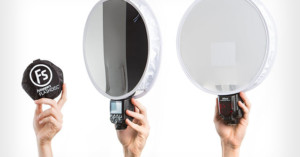
The FlashDisc by Fstoppers is a portable softbox that can fit into your pocket when its not in use, thanks to a design that allows it to fold up in a manner similar to portable light reflectors. It allows photographers to achieve soft directional light in situations where larger softboxes are impractical.

Light modifiers don’t come cheap, especially softboxes. But, if you have enough DIY talent, some patience, and $20 bucks to spare, you’re only an hour or so away from having a custom-made softbox of your own.

When trying to perfectly light an object, there’s a method of shooting it inside of an environment called a lightbox -- essentially a 360° softbox that emulates the soft, natural, even lighting you would get on an overcast day.
Lightboxes are fairly small in size, meant for lighting small objects for product photographs and so on. But what if it were possible to create a human-sized lightbox for use with people? It turns out you can, and in the BTS video above, photographer Kevin Lynch shows off his version.

In a perfect world, we'd all have the studio of our dreams, and it would be filled with all of the best of gear. Unfortunately, we don't live in such a world, and more often than not we're constrained by a (sometimes very tight) budget.
Here to help overcome that challenge is Jay P. Morgan of The Slanted Lens, who has put together a video that shows just how easy it can be to build a very viable studio out of fairly cheap materials/products in a spare bedroom.

When it comes to taking product shots of glossy items, one of the most difficult aspects is getting the correct amount of diffusion when using softboxes. When the incorrect amount of diffusion is applied (or the right amount is applied incorrectly) this can lead to harsh reflections and minimal gradients, which isn't usually the look you're trying to achieve.

You know those perfectly overcast days, where the clouds just perfectly diffract the sunlight, turning the world into a beautiful, evenly-lit soft box? Imagine if you could have that indoors when trying to shoot a subject.
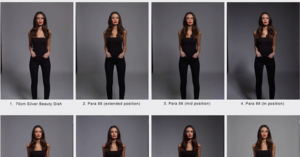
A few weeks ago, we shared a video by photographer Karl Taylor that gave you a behind the scenes look at what a day-long fashion shoot in his studio was like. And even though a few of our readers poked fun at the video's obvious product placement, a lot of people learned a thing or two and came back with followup questions regarding the light modifiers that Taylor was using throughout the day.
Fortunately for us, Taylor was listening, and has produced this very informative follow-up video in which he discusses the differences between his go-to modifiers, complete with side-by-side comparisons.